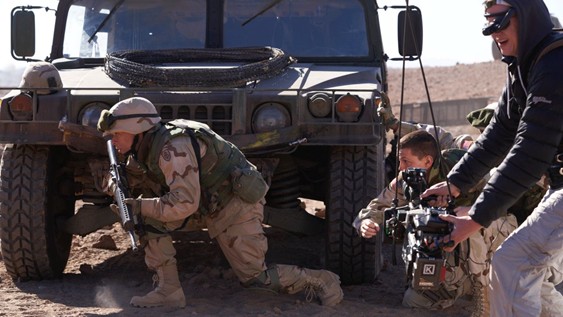
When it comes to shooting some of the biggest action movies that have hit the multiplexes almost every summer, there are few people who get closer to the action — besides the stuntmen and women, obviously — then the camera operator. As the A-camera operator for some of the biggest action blockbusters of all time (and that’s no exaggeration), there’s a good reason why Geoffrey Haley is considered to be at the top of his particular game as a camera operator.
Looking over Haley’s filmography can take your breath away, because over the past twenty-five years, he’s operated camera on everything from Oscar-winning movies to four of the Fast and Furious movies (including the upcoming F9), acclaimed films like Todd Phillips’ Joker, and some of Marvel Studios’ biggest movies, as well.
This interview was conducted with Haley a few hours before this year’s Society of Camera Operators celebration where Haley was nominated for Camera Operator of the Year for his work on the Russo Brothers’ action-thriller Cherry, starring Tom Holland. This followed receiving that honor last year for his work on Joker, and it continued Haley’s relationship with the Russos after he operated A-camera on both Avengers: Infinity War, and its sequel Avengers: Endgame.
As we learned, Haley had most recently been operating A-cam on the Russos’ current movie, Gray Man, for Netflix. (Spoiler: Haley won his second consecutive Camera Operator of the Year a few hours after this interview.)
Below the Line: Congratulations on your fifth nomination for SOC Camera Operator of the Year after winning last year.
GeoffreyHaley: I’m up for a second potential one this year, that’s right.
BTL: Are you attending or watching tonight?
Haley: I am. I’m attending and watching. I’m also presenting some things, as well. So I’m fairly involved in the whole thing. [Laughs]
BTL: The ceremony is an hour and a half long, but the SOC only gives out two awards in that time?
Haley: Oh, no. There’s a whole bunch. That’s why we also call it a celebration. So we have clips from past award shows. And then we also have put together things from like the year in COVID, and all sorts of stuff. Actually, it’s probably going to run long, maybe closer to two hours even though there’s two awards. [laughs]
BTL: I’ve spoken to quite a few DoPs over the years, but you’re the first actual camera operator..
Haley: I’m honored
BTL: Your body of work is pretty amazing. I was looking over your IMDB and you’ve been working in camera for a long time, but you’ve also directed a movie.
Haley: Actually, the movie I’m camera operating right now, this big Russo Brothers movie with Ryan Gosling and Chris Evans called Gray Man. [It’s] a big $250 million action-adventure Bourne Identity meets Mission Impossible kind of movie. So I’m the A-Steadicam operator, but I also got an upgrade this time. I’m also an Executive Producer on the movie, so that’s my new title on it.
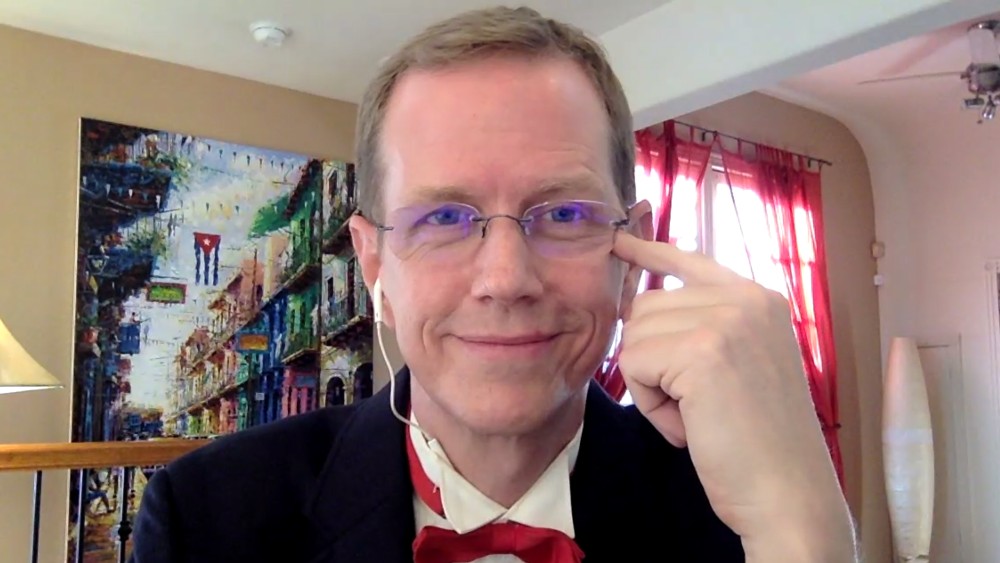
BTL: That’s pretty cool. I guess they’re realizing how important what you’re doing is adding to their movies.
Haley: With the Russos, I have sort of a special relationship, where I tend to get very involved with the storytelling part of it. I had 18 weeks of prep on this movie. Most of what I do isn’t even in camera stuff. It’s more like story and figuring out how we want to tell the story and do stuff. So it’s a lot of fun with those guys.
BTL: You kind of answered a couple of my questions but you’ve done a few movies with the Russo Brothers now, so are you usually hired by the directors or by the DP on a movie normally?
Haley: Yeah, it’s interesting. Now, I have to put a caveat in this. I am not necessarily your typical operator, in the sense that the next operator you talk to may have some very different answers to some of these specific questions. I think I’m a slightly different mold of operator than then some of the more traditional operators. Most traditional operators are generally hired by the Director of Photography. Now, as you get up in the experience, and you’ve been around the scene a little bit longer, then you can start to get hired by some other folks. So generally speaking, there are some actors that usually request me. I’ve done, I think, 11 movies with Dwayne Johnson, so he’s one of those people. There are several directors that will hire me before they’ll hire the Director of Photography. I’d say about 50% of the jobs that I do now, I’m hired by the Director of Photography, the other 50% I’m either hired by directors, actors or producers, generally speaking.
BTL: That’s interesting to hear about Dwayne Johnson, because there is such a special relationship between the camera and the actor that’s sometimes overlooked.
Haley: Yeah, very much. It’s interesting, because to a degree, the job of the camera operator is said — and I really believe it — is kind of the best job on this set, in that you get to show up, and you get to be the person who sees it first. You’re actually looking through the camera and composing the shot. At the same time, you also can really just think about how to make the best movie, like how to visually tell the story. Much more so than the Director of Photography, who has two other departments they have to worry about. They have to run grip and electric, and they have to worry about the schedule, and they have to worry about the lighting and the budget and all that sort of stuff.
The operator is in a very luxurious situation where they can just show up in the morning, look at the sides, already having read the script several times, and being like, “What’s the best way to tell this story and think about just that.” It’s such a luxurious place to be. That’s why I love operating camera, so much more than I could ever enjoy being a Director of Photography.
BTL: That makes sense, and you answered another one of my questions which was how much prep was involved, or do you generally just show up on the day of the shoot and do what’s needed?
Haley: Yeah, again, it depends. I’ll tell you, the first answer is what the average operator probably gets, is if you’re the A-camera operator, there’s going to be some test shooting that’s going to be done makeup, wardrobe, hairstyles, maybe visual tone testing — stuff that you’ll do during prep. But generally speaking, the operator won’t get much more than a week or two of prep. In my case, I have gotten as much as a month of prep and on the movie that I’m on right now, 14 weeks of prep, but that’s probably also because of my executive producer role. So 14 weeks of prep is highly unusual for an operator, generally speaking,
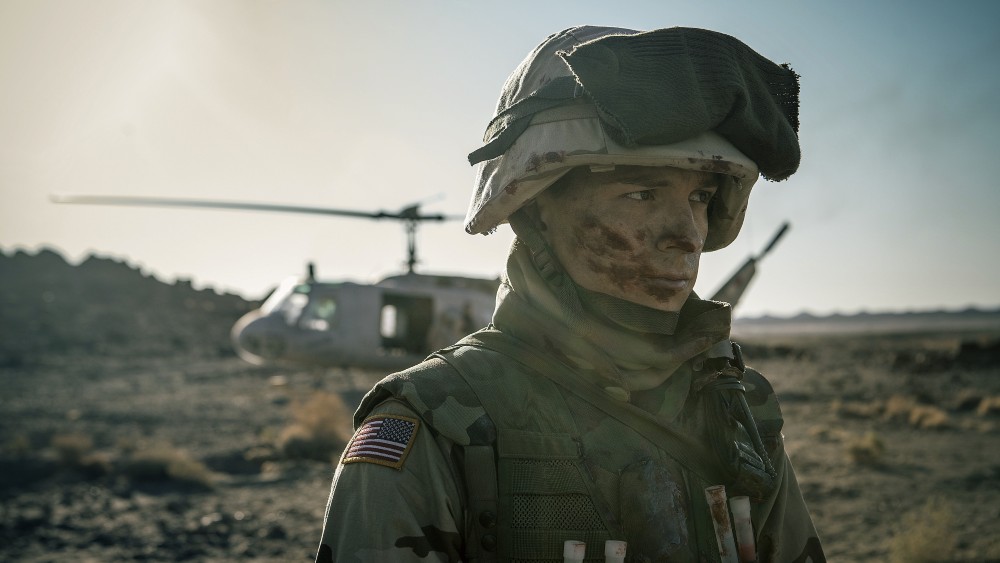
BTL: In that case, would you also be working with the stunt team to figure out how to shoot that stuff?
Haley: Very much so. On a movie like this, I’m working obviously with the second unit director, I’m working with stunt departments, I’m shooting previz with the stunt department. We’re talking with the visual effects supervisors, with the art department, and then getting sometimes into story meetings, and even talking in meetings where the directors are talking with actors, again, about how we want to tell the story, the tone, the visual, representation of the story, I’m involved in with a lot of those meetings as well.
So it tends to be a mishmash of all different kinds of departments, especially the more directly related departments are to the actual visual storytelling, the more I’d probably be involved in some of those meetings, less so with some of the other meetings. I’m not really that involved, say, with the makeup department, for example, or the wardrobe or hair. I won’t really start to deal with those departments until we start doing tests much closer to the start of shooting, essentially.
BTL: For Cherry, had you worked with Newton Thomas Sigel before or was this the first time?
Haley: That was the first time I’d worked with Tom, and it was a really great experience. Obviously, he’s also got a glowing resume and an amazing reputation. The brothers are so very collaborative. One of the things about them is that they’re very good at inspiring the people around them to do the best possible work. That’s sort of their superpower. They’ve got this energy and this positivity, and they imbue the people around them with an ownership of the project, which makes everybody want to just do the best possible work of their lives. That’s wonderful about the Russo brothers, and I think Tom, he really embraces that idea as well. You know, wherever the best idea comes from, he embraces that. It was great, because on Cherry especially, it was a fraction of the budget of the movie I had finished with the Russos before, you know, close to a billion dollars of a budget for Infinity War and Endgame.
So Cherry was $20 million, I mean it was tiny. It was basically the fuel budget of Endgame, so that meant we had to be very creative, because we didn’t have all the toys. It was a one-camera shoot, essentially was one camera at a time. We didn’t have a second camera operator until we actually got to some of the Morocco stuff. And so we had to do a lot more with a lot less, but at the same time also, because the Russos really wanted to expand and explore lots of different types of visual styles in almost subjective and I would say almost sort of art film kind of ways, we were really able to just go out there and say, “Look, what can we do, even if it flies in the face of conventional Hollywood storytelling, what’s the best way to tell this part of the story?” Because of the way that this film is designed, it’s got six different chapters in it, and each one of the chapters has a completely different look.
Like one of the chapters– the chapter with the story of the main character going to boot camp — we told that entire chapter, which is a 20 minute chapter, I think, with just one wide-angle lens. Our rule was, we could only use one lens that was like an 11 millimeter. Whatever we did, we had to use just that lens. We set ourselves these really fantastic sort of challenges. Can we tell this story with one arm and one foot tied behind our back? What does that produce? What kind of inspirational and artistic choices does that bring into play?
I think that film is a better film for it. It was really enjoyable, because we didn’t have to worry about, again, do we need to make $150 million to make the studio happy? No, this was a film that was just an intimate story that the Brothers felt very, very close to and attached to emotionally. And we were able to approach it from all all sorts of sides that you would normally not approach it from in Hollywood settings.
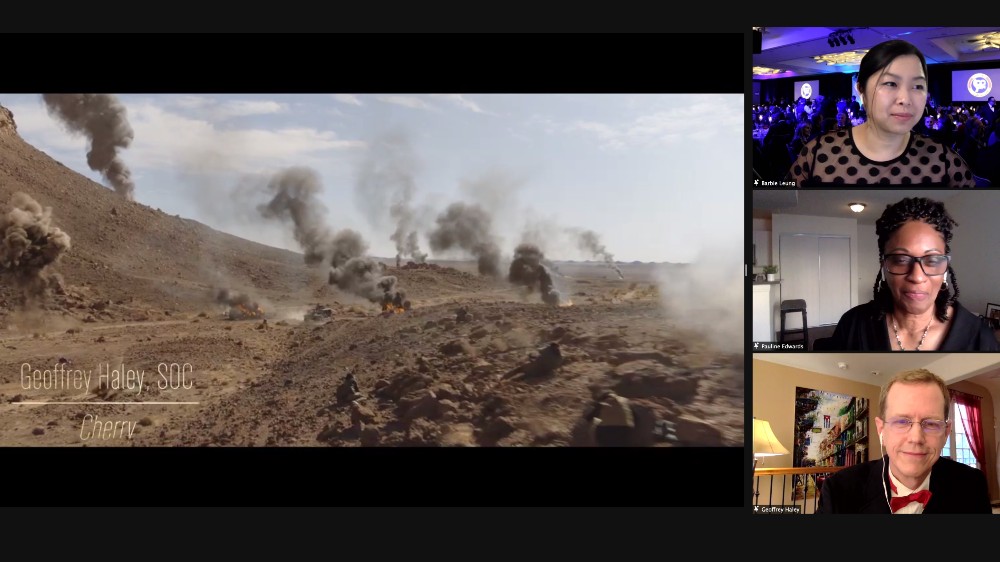
BTL: I haven’t spoken to the Russos in a while, maybe for one of the Captain America movies, but after making such huge, huge movies, I was curious if it was possible for them go from an almost unlimited budget to go back to making smaller movies…
Haley: Yeah, like, the old days, right? “You’ve got a camera and a tripod, one light and four days, go make a movie,” like that kind of thing. I’d say there’s something very liberating about that style of shooting. I think that, in general, and look, we’ve all done our share of low-budget movies, so now having done a share of massive mega-million dollar budget movies and a small bunch of movies, there’s something very liberating about coming onto a project where you do face limitations. Limitations where you have to be like, “Okay, how can we build a better mousetrap with less stuff?” It’s easy to build a better mousetrap with unending budgets, an infinite amount of time, and a cast of thousands to be able to to realize your every vision, but how do you do it when you have no time, no money, and all you have is a creative idea to try to make it work. In a weird way, I think some of the best filmmaking comes from that environment. You can get yourself into quite a fix sometimes when you’ve got these huge paletes with too much. I’m glad we were able to get back to that on Cherry.
BTL: I noticed you directed a movie, too, which I saw at Sundance. When I saw your name for this interview, I didn’t quite put two and two together. When you were directing your own movie, did you still operate the camera or do you have someone else doing it while you direct?
Haley: So on The Last Word, that movie that you saw at Sundance, I did operate myself. That’s partly because that was a movie shot on film. There’s a very interesting thing that has happened during the transition from film to digital. I’m sure you’ve had lots of DPs, that have told you this as well, or maybe other people that you’ve talked to, but it used to be that when you were looking through a film camera, you literally had the best seat in the house. You actually were able to see what the image was going to look like, which is why a lot of Directors of Photography liked when they were lighting, they weren’t back at a DIT tent. They weren’t looking at a monitor. They were looking through the camera. Even if they walked away, to give the camera operator the seat when it was time to execute the shot, they were still most likely looking through that camera when they were actually lighting. As the camera operator that was great, because again, we were able to really see the film the way it was going to be seen by the audience when it was being shot with film versus the crappy video taps that started back when Jerry Lewis put a black and white video camera right next to the film camera. He was the one that invented video assist, right? Up until HD, the video assist was a horrible rendition of what the movie would actually look like, and so the camera operator had a very privileged seat, because we were the only ones that were able to see — with the exception of the DP who was lighting before the camera operator took over.
When digital came into play, things changed a little bit because now actually, the crappy image through the eyepiece or through the five-inch monitor is now at the camera, and the Director of Photography is now looking at a gorgeous 25-inch 4K OLED with literally their DIT (digital imaging technician), who has basically the same tools that the color timer does at Company 4 or wherever
It’s very interesting, because now you’ve got the camera operator, that’s why fewer DPs are operating, because they want to actually see the great image, and they’re saying, “Okay, camera operator, you deal with the crappy image, you just execute the shot, and I want to see what it’s going to look like.
Sorry for the long-winded answer, but when I was directing my film, that was still anamorphic 35mm film, and of course, I was greedy. The best performances were going to be able to be seen through the camera because again, the film lens was the best way to look through it. After that film, I didn’t operate. I did a number of episodes of television and in television, it doesn’t matter who you are, you’re not operating the camera if you’re the director, because usually, you have multiple cameras on the set at the same time. You need to be able to be sitting back at video village, and you’ve got your executive producers, and you’ve got your writers and they’re all sitting next to you, and they’re whispering into your ear. You need to see two and three cameras all at the same time. The film that I directed, I did operate and the film that I am prepping right now to be possibly shooting later this year, early next year, which will also be digital, but I may go back to operating that myself. It depends, I’m not sure exactly.
BTL: I want to ask about shooting action, because you do a lot of it with the Fast and Furious movies…
Haley: Star Trek and G.I. Joe and all that stuff.
BTL: But first, I was looking over your resumé, and I saw that you operated on Crank with Mark Neveldine and Bryan Taylor.
Haley: Yes, that’s right. [laughs]
BTL: I know those guys are pretty crazy in how they shoot action, so that must have been good practice for all these other movies you’ve done since then.
Haley: For sure.
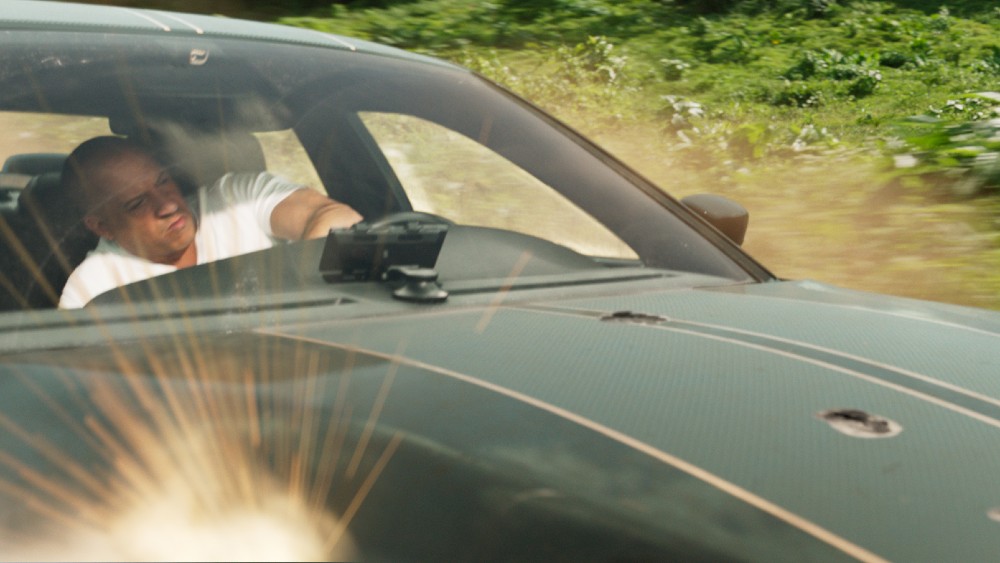
BTL: How is it operating on those big action movies? I assume it’s kind of dangerous because you may be operating fairly close to the action as humanly possible, so what’s that like?
Haley: Look, I will say this. Operating on action films is quite different from operating on dramas and comedies and suspense thrillers, in that yes, you are sometimes put — especially with the Fast and Furious films–I’ve done four of five of those now, I don’t remember how many of them — but we pride ourselves from the very beginning of that franchise to try to do as much of that work in-camera as possible. Now, look, as those films have gotten more absurd, yes, you’ve got more CG elements, you’re not going to have like the last one. I think we had a submarine chase underneath the Iceland ice sheet with a Lamborghini on top. We didn’t have an actual submarine down below. But generally speaking, we do try to have as much real car action with a lot of the stunts being as real as they possibly can be. In situations like that, yeah, you can put yourself into some rigs and things that can be a little bit dangerous, and some of the fight sequences and so on, because you always want to do, then the next best, greatest thing. You don’t want to do the stunt that we did three movies ago; you want to do the better stunt. So it can be a little bit more dangerous, and certainly the adrenaline level goes up, but the adrenaline level really also goes up, because as a camera operator, you want to make sure that you don’t mess up. Because if you mess up, that means that you might have to go again. If you go again, that means that that stunt person or those group of stunt drivers or those people, they’re putting themselves into harm’s way, have to do the stunt again. The last thing you ever want is to miss a shot and say, “I didn’t get that we have to go again.” And then you go again and somebody gets injured or, God forbid, dies. When we do dangerous stunts. I get real serious very very quickly, and I spend a lot of energy focusing on what I have to do, because I need to make sure that we get it the first time and we get it right.
BTL: You’ve obviously been working over the past year during COVID, what sort of things have you had to deal with as far as safety protocols, which adds a whole new layer to everything?
Haley: I was on a movie called Red Notice, another Dwayne Johnson movie with Ryan Reynolds, it’s coming out later this year, I think on Netflix. We were about four or five weeks into that and we got shut down in March. We knew we had another 10 or so weeks. Actually, we were about 10 weeks in and had another 10 weeks to go, something like that. We came back in mid-to-late August, and I think we were the only movie in the US with the one exception maybe of a Tyler Perry movie. We completely sequestered 100%, the entire shooting crew. Everybody was sequestered when we got back, so there were two hotels, and everybody was at those hotels. Even people that were working locally, they couldn’t ever go home, they couldn’t see their family. We couldn’t pump our own gas, we couldn’t get groceries, nothing. And we were still wearing face masks, and we were still wearing shields, and we were still getting tested five times a week.
I will say, because this was August, and there was the second surge, another spike. I felt extraordinarily safe while we were there, but that said, especially shooting action, and as a Steadicam operator, I’m doing a lot of high-energy exhausting aerobic stuff. I’m running around with a 60-pound camera when we’re doing steadicam or handheld or whatever it is. Adding that layer of complexity of an N95 mask, you’re wearing goggles or glasses, those are fogging up, unless you’re wearing a shield. You can’t take a drink of water anywhere near set, because you’ve got to go outside to take your mask off to take a drink of water. I will say it was very challenging, especially for the first five or six weeks, because it was sort of the equivalent of… during COVID, you know how long-distance runners and certain elite athletes go up into high-altitude scenarios and train there because they get less oxygen? I should have been smart enough to go to the top of the Pyrenees or something to try steadycamming up in those high elevations, because wearing those masks with those other layers really meant that I had a lot less oxygen, and it was very tough for the first couple of weeks. And then, you slowly get used to it. You also lose your voice. Right now my voice is totally hoarse, because especially as the A-camera operator, you’re talking to everybody. You’ve got 150 questions launched at you throughout a day, and you have to shout all your answers back. So by the end of the day, your voice is gone.
It was a lot of interesting challenges with COVID you wouldn’t think about until you start dealing with, “Oh, geez, yeah.” I’m glad that we’re getting out of it. Let’s put it that way. I’m hoping that this movie will be the last movie that I’ll have to be wearing a mask for.
BTL: You should try to get on that movie that Tom Cruise wants to do in space, because if you did that, you’d be up for any other challenge .
Haley: That’s right, that’s totally right. [laughs]
You can see Haley’s amazing work in Cherry, which is currently available to view on Apple TV+ or check out the trailer for Cherry and the newest F9 trailer below that, because you’re likely to see a good amount of Haley’s work in both of those as well. You can also learn more about the Society of Camera Operators at SOC.org.





